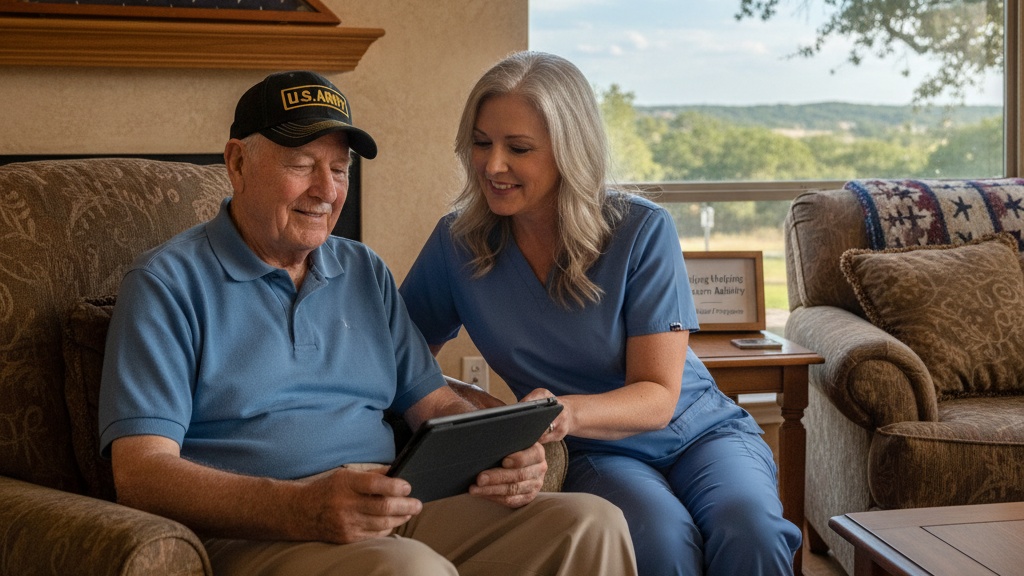In the heart of Texas, where the spirit of service runs deep, Helping Restore Ability (HRA) stands as a beacon for veterans seeking to maintain their dignity and independence at home. Founded in 1977, HRA has dedicated nearly five decades to empowering individuals with disabilities, and its VetAssist Program is a cornerstone of veterans assistance in Texas. This initiative connects qualifying wartime veterans, their spouses, and surviving spouses with the VA Aid and Attendance pension, providing up to 19 hours of no-cost weekly in-home care. As we navigate 2025, with updated VA rates and eligibility guidelines, understanding programs like VetAssist is more crucial than ever for those facing non-service-connected disabilities.
What is the VetAssist Program?
The VetAssist Program is designed to bridge the gap between veterans’ needs and accessible support. It helps eligible individuals apply for the VA Aid and Attendance pension – a tax-free benefit that supplements income for those requiring assistance with daily living activities. According to the U.S. Department of Veterans Affairs (VA), this pension is underutilized, with many eligible veterans unaware of its potential to fund in-home care. HRA steps in by handling the complex paperwork, ensuring applications are accurate and efficient, and connecting participants with trained, screened attendants.
In Texas, where over 1.7 million veterans reside (per Texas Veterans Commission data), programs like VetAssist address critical gaps. Arlington alone is home to more than 15,000 veterans, many dealing with age-related challenges or chronic conditions. VetAssist offers a lifeline, allowing participants to avoid nursing homes and stay in familiar surroundings, which research from the VA shows can reduce hospitalizations by up to 30% and improve mental health outcomes.
Key Benefits of In-Home Care for Veterans
The advantages of in-home care extend far beyond convenience. Studies from sources like the VA’s Geriatrics and Extended Care program highlight that veterans receiving such support experience enhanced quality of life, with lower rates of depression and isolation. In Texas, where VA-funded in-home care has faced cuts (e.g., a drop from 37% to 11% of enrollees getting over 20 hours weekly between 2024 and 2025, per CBS News reports), private-duty options like VetAssist become essential.
- Independence Promotion: Assistance with bathing, dressing, and mobility helps veterans retain control over their lives.
- Family Relief: Reduces caregiver burnout, as noted in VA statistics showing 40% of family caregivers report high stress levels.
- Cost Savings: No out-of-pocket expenses for eligible participants, funded through the VA pension (2025 rates: up to $2,358/month for single veterans, $2,795 for married couples, and $1,515 for surviving spouses).
- Health Outcomes: In-home care correlates with 25% fewer emergency visits, per Texas-specific data from the Texas Health and Human Services.
Moreover, HRA provides interest-free loans for immediate care needs while applications are processed, ensuring no delays in support.
Detailed Eligibility Criteria: The 4M’s Explained
Eligibility for the VA Aid and Attendance pension via VetAssist hinges on the “4M’s,” as outlined by the VA for 2025:
| Criterion | Details | 2025 Updates/Notes |
|---|---|---|
| Military Service | 90 days active duty with at least one wartime day; honorable discharge. Gulf War vets: 2 years or full duty period. | No changes; includes periods like WWII, Korea, Vietnam, Gulf War. |
| Medical Condition | Non-service-connected disability requiring daily assistance (e.g., bathing, eating). | Must be 65+ or permanently disabled; housebound or nursing home status qualifies. |
| Money Limitations | Net worth under $159,240 (excluding home/auto); income deductions for medical expenses. | Limit increased from 2024; unreimbursed costs can lower countable income. |
| Marriage | Spouses: Married 1+ year to veteran; surviving spouses must remain unmarried or meet specific remarriage rules. | Remarriage post-1971 and ended pre-1990 may qualify. |
If you’re unsure, HRA offers free eligibility checks to guide you through these requirements.
The Application Process: Step-by-Step Guide
Applying can seem daunting, but HRA simplifies it. Start by gathering documents like DD-214 (discharge papers), medical records, and financial statements. HRA’s team assists with form submission to the VA, which typically processes claims in 3-6 months. In the interim, interest-free loans cover care. For Texas residents, complementary programs like the Texas Veterans Commission’s Fund for Veterans’ Assistance (awarding $10.9 million in grants in 2025) can provide additional support.
Once approved, funds are directed toward in-home services, with HRA monitoring compliance to maintain benefits.
Real-World Impact and Testimonials
While privacy protects specific stories, general feedback from VA programs indicates veterans feel more empowered. One hypothetical scenario: A 75-year-old Vietnam vet in Arlington, struggling with mobility, receives 15 hours weekly of care, allowing him to host family gatherings at home – a small but profound victory.
Conclusion: Take the First Step Toward Independence
In 2025, with rising healthcare costs, HRA’s VetAssist Program offers a vital pathway to disability services for veterans. Don’t let bureaucracy stand in the way – contact HRA today at 817-469-1977 or visit hratexas.org/veterans to check eligibility and start your application. Your service deserves this support; let HRA help unlock it.

